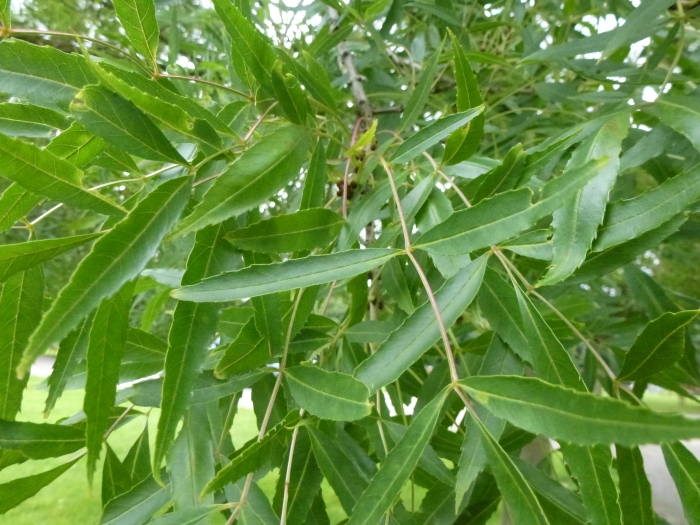Narrow-Leaved Ash
(Fraxinus angustifolia)
Narrow-Leaved Ash (Fraxinus angustifolia)
/
/

© Susan Marley
CC BY 4.0
Image By:
© Susan Marley
Recorded By:
Copyright:
CC BY 4.0
Copyright Notice:
Photo by: © Susan Marley | License Type: CC BY 4.0 | License URL: http://creativecommons.org/licenses/by/4.0/ | Uploader: susan_marley | Publisher: iNaturalist |









































































Estimated Native Range
Summary
Fraxinus angustifolia, commonly known as Narrow-Leaved Ash, is a deciduous tree native to riparian forests, often found along riverbanks and in wetlands across the Mediterranean region, the Middle East, and the Balkans. This species typically reaches 20–30 meters in height with a trunk up to 1.5 meters in diameter. The bark on young trees is smooth and pale grey, maturing to a square-cracked and knobbly texture. The Narrow-Leaved Ash produces inconspicuous flowers in inflorescences, which can be male, hermaphrodite, or mixed. All trees are functionally hermaphrodite, bearing both male and hermaphrodite flowers.
The Narrow-Leaved Ash is valued for its adaptability to wet conditions and is often used for reforestation in riparian zones. It is also planted in urban areas for its ability to tolerate air pollution and confined soil spaces. In cultivation, it requires full sun to part shade, moist soil, and can handle a range of soil types, though it prefers those that are well-drained. While it is not known for showy flowers, it provides a lush canopy and contributes to the ecosystem by stabilizing riverbanks and supporting wildlife. Gardeners should be aware that this species can be potentially invasive outside its native range and may be subject to diseases such as ash dieback.CC BY-SA 4.0
The Narrow-Leaved Ash is valued for its adaptability to wet conditions and is often used for reforestation in riparian zones. It is also planted in urban areas for its ability to tolerate air pollution and confined soil spaces. In cultivation, it requires full sun to part shade, moist soil, and can handle a range of soil types, though it prefers those that are well-drained. While it is not known for showy flowers, it provides a lush canopy and contributes to the ecosystem by stabilizing riverbanks and supporting wildlife. Gardeners should be aware that this species can be potentially invasive outside its native range and may be subject to diseases such as ash dieback.CC BY-SA 4.0
Plant Description
- Plant Type: Tree
- Height: 30-60 feet
- Width: 15-30 feet
- Growth Rate: Moderate
- Flower Color: N/A
- Flowering Season: Spring
- Leaf Retention: Deciduous
Growth Requirements
- Sun: Full Sun, Part Shade
- Water: Medium
- Drainage: Slow, Medium, Fast
Common Uses
Bee Garden, Bird Garden, Butterfly Garden, Deer Resistant, Drought Tolerant, Hedges, Low Maintenance
Natural Habitat
Riparian forests and wetlands across the Mediterranean region, the Middle East, and the Balkans
Other Names
Common Names: Desert Ash, Narrow-Leaf Ash, Schmalblättrige Esche, Smalbladig Ask
Scientific Names: , Fraxinus angustifolia, Fraxinus oxycarpa var. angustifolia, Fraxinus angustifolia var. pojarkoviana, Fraxinus excelsior f. angustifolia, Fraxinus excelsior f. parvifolia, Fraxinus excelsior subsp. angustifolia, Fraxinus excelsior var. angustifolia, Fraxinus excelsior var. australis, Fraxinus oxyphylla subsp. angustifolia
GBIF Accepted Name: Fraxinus angustifolia Vahl